Consistently ranked among the world’s top cities to visit by magazines like Travel and Leisure, and Conde Nast Traveler, Florence is an Italian treasure to put on your list -- but spend enough time there to do it justice. These pages will show you exactly how to get the most out of an ideal visit, which is all about culture, history, art, people, shops, architecture, museums, palaces, food and fun.
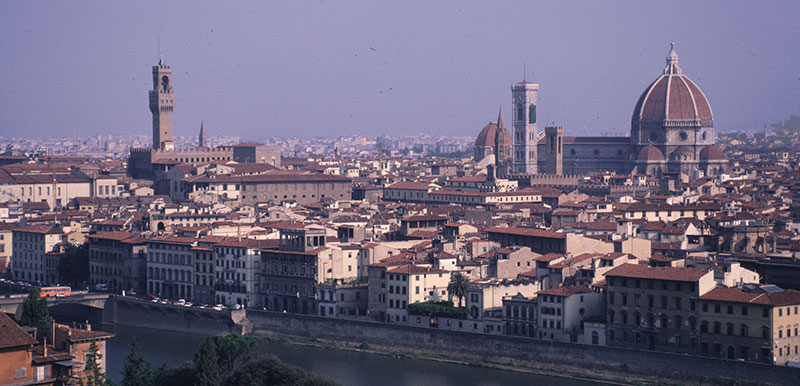
It takes more than one day to fully experience Florence, so here we spread the visit out over three days, with specific itineraries for each day. Hopefully you can spend at least that much time there, but if you have more or less time, just modify these suggestions to suit your interests.
DAY ONE: Duomo, back alleys, Piazza della Signoria, Uffizi, Santa Croce, and Casa Buonaroti.
DAY TWO: Piazzale Michelangelo, Pitti Palace, Oltrarno, Ponte Vecchio, shopping, Accademia.
DAY THREE: A few more museums, shopping, wander the alleys, and perhaps a quick trip out of town.
Short video of arrival. lunch, and a parade.
Tuscany’s capital is most famous as the birthplace of the Renaissance -- the city where art took major leaps during the 14th and 15th centuries combined with advancements in science, literature, politics and business to help pave the way to our modern civilization. By 1300, Florence was already considered Europe’s largest and wealthiest city, with historic roots that reached all the way back to the ancient Romans, who founded the town and laid out many of the streets in the grid pattern still used today.
With the patronage of the Medicis, superstars of the art world like Leonardo da Vinci, Michelangelo, Raphael, Botticelli, Brunelleschi, Donatello, Giotto and many more, created masterpieces here which defined new ways of seeing that still influence us with their dramatic use of perspective, color and realism. Great Florentine thinkers like Galileo, Dante, Boccaccio and Machiavelli also played important roles in their hometown. The great Medici dynasty managed to provide a stable government throughout this time, despite constant military threats from the nearby city-states of Pisa and Genoa. This confluence of talent was unique in history, with more important geniuses gathered in one small place than ever before or since.
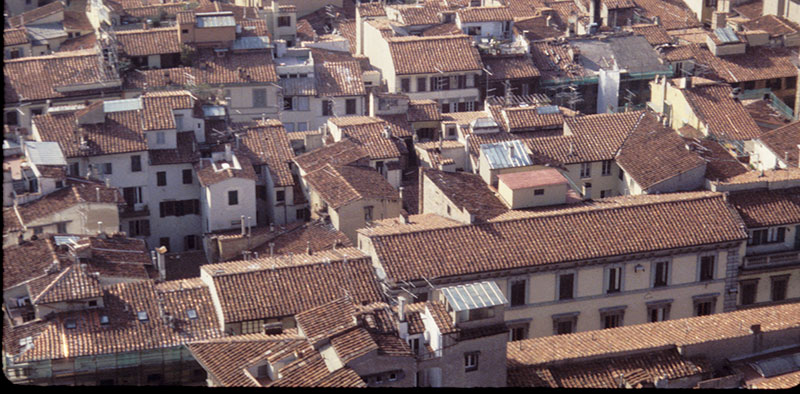
The history created by these great people is a dramatic story that has been partly frozen in stone, displayed in the beautiful architecture now seen in the ancient buildings of the city center. Florence looks much like it did centuries ago, filled with wonderful palaces, piazzas and more art per square inch than any other city on Earth.
.jpg)
As a bonus to the art and history here, you also get to experience some of the best street markets, for leather goods and the usual souvenirs, or can shop up-scale in the many fancy boutiques that line the quaint narrow medieval lanes. For those more interested in shopping than art, you are in retail heaven. Florence is especially famous for its locally manufactured high-quality leather goods, and while Hawaii people do not need much in the way of leather clothing, you will still enjoy the beautiful shoes and handbags. If you are ready for serious spending, there are plenty of designer boutiques and the jewelry shops to discover. If you just want some small leather items, the numerous sidewalk stands clustered around the church of San Lorenzo have low prices on a variety of wallets, belts, lipstick holders, bags and souvenirs of all kinds.
Florence is an ideal city for walking, as the distances are short and many lanes are reserved just for pedestrians, so wear comfortable shoes and come along as we show you the sights. The main part of town is only one square mile, but densely packed with interesting things to see -- so you do need several days to catch it all. Don’t let the town’s 66 museums intimidate you, because we will show you how to navigate the important sights. It would be possible to squeeze this schedule into two days, but with three days you can enjoy a more leisurely approach, with time for shopping and relaxing at a café to digest the massive amounts of stimulation you’ll get from the historic streets, monuments and museums. Because the town’s small size makes it easy to get around, you could juggle our itinerary and change the order of events with little logistical difficulty if it suits your purpose, but we have done our best to lay things out for you here in an efficient, logical sequence.
DAY ONE: Duomo, back alleys, Piazza della Signoria, Uffizi, Santa Croce, and Casa Buonaroti.
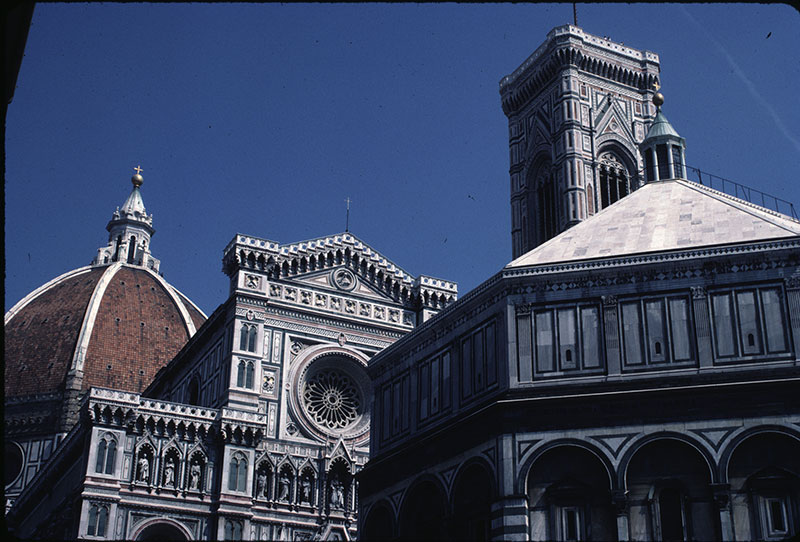
Start your first morning at Florence’s most important landmark, the great Duomo Cathedral, which was the tallest building in Europe when it was finished in 1434, and is still the world’s fourth largest church. You can easily find it by looking up from almost anywhere in town, for the huge dome towers 300 feet over the city. This ever-present dome is a handy landmark that will keep you oriented throughout your stay, especially since the rest of town is low-rise, filled with historic buildings about four stories high.
Back in the Middle Ages the residential buildings were actually much higher than today, with nearly 200 “skyscraper” towers that reached up to 240 feet, built for status and defense, until a more egalitarian-minded government cut them down by half in the mid-13th century. At the same time a building boom commenced, with the construction of the cathedral, Palazzo Vecchio, and Santa Croce, all designed by the same Gothic genius, Arnolfo de Cambio.
The 500 foot-long cathedral was an immense achievement of the medieval masons who invented new construction techniques as they worked, creating Europe’s largest building. The vast exterior was covered with multi-colored marble, arranged in geometric patterns related to the carpets and fabrics that were created by their wool industry, the most important business in Florence. The wool guilds were the main financiers of the cathedral, eager to show off their success and create an attraction that would draw travelers from throughout Europe, to further enhance their prestige and sales.
Unfortunately, for the first hundred years of construction they could not figure out how to build a roof to cover the huge hole over the altar, until Filippo Brunelleschi came along in the early 15th century with his brilliant plan for a great dome that spanned the gap. Some historians suggest that the Renaissance began with the completion of that dome. You can climb it if you feel adventurous and can spare an hour, winding your way up a narrow staircase between the inner and outer shells, emerging at the top to a spectacular view over the city.

The Baptistery is probably the oldest standing building in Florence, built over a thousand years ago, but choose to pay for entry only if you want to see the impressive ceiling mosaic of the Last Judgment. The most famous treasures of the Baptistery are on the outer doors, especially copies of the “Gates of Paradise” by Lorenzo Ghiberti (1425-1452) on the side facing the Duomo, important for their early use of perspective. Compare these vivid scenes with the prior Gothic approach of Andrea Pisano (1333) on the south side, where figures are rigid in the typical medieval style.
The Piazza del Duomo in front of the church has another fascinating structure covered in similar multi-colored marble, Giotto’s Bell Tower, which also charges admission, but you can happily appreciate it from outside for free. You could walk up the tower for an thrilling view of the cathedral, but the dome is far more exciting to climb. These buildings are so big it is hard to see or photograph them, but there are some good camera angles from the edge of the piazza on Via de’ Pecori opposite the Duomo facade, which gets you far enough away so you can take it all in.
For those interested in sculpture and the history of the Duomo, walk around behind the cathedral to visit the Museo dell’Opera del Duomo, which has several rooms of beautiful statues taken from the cathedral, especially Della Robia’s Choir Galleries, Verrocchio’s reliefs, Michelangelo’s final Pieta, Ghiberti’s original panels from the Baptistery doors, Arnolfo di Cambrio’s gothic statues -- and perhaps most interestingly of all, the actual tools used to build the great dome, with explanations of how it was done.
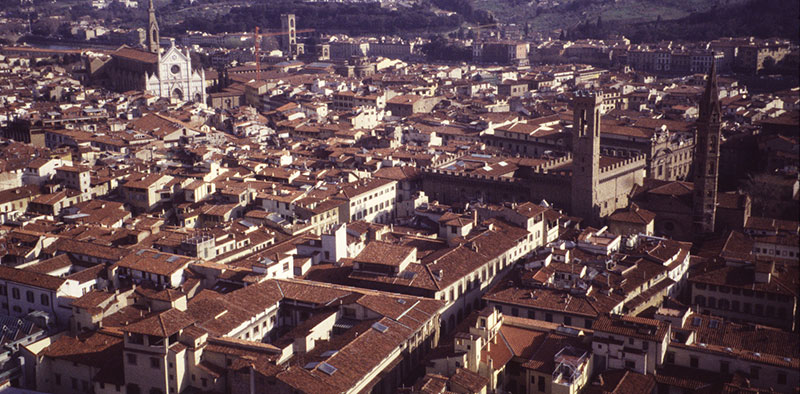
BACK ALLEYS:
Next, meander through the narrow back alleys heading towards Piazza della Signoria and the Ponte Vecchio. Take your time and explore these charming little pedestrian streets to gain a feeling of life in the Middle Ages, for the buildings have not changed much since then. It’s easy to find your way through the regular grid of lanes named Oche, Studio, Cerchi, Presto, Magazzini and Corso -- so don’t just follow the typical tourist route along Via dei Calzaiuoli, which is the main street of tourist Florence that you will inevitably spend time on anyway, checking out its many shops and eateries.
Get off the beaten track to escape the mobs and soak up the quiet atmosphere of the side streets, looking for medieval towers, tiny churches, neighborhood trattoria, corner snack shops, and locals out for a stroll. A favorite spot is the tiny Piazza Santa Elisabetta, with three surviving towers from the Middle Ages, the earliest one uniquely oval in shape and belonging now to the deluxe Hotel Brunelleschi next door.
.jpg)
After thirty minutes of wandering you will arrive at the Piazza della Signoria, the town’s other major square, with its many statues, cafes, and the massive architecture of the Palazzo Vecchio looming above, the center of political power for 700 years. Looking like a giant castle with its tower reaching 95 meters, the Palazzo Vecchio is open as a museum that could be worth your time in a few days, after you have covered the most important sights. Do have a quick look in the front door to admire the grotto design of the courtyard, and a bronze replica of Verrochio’s puto holding a dolphin.
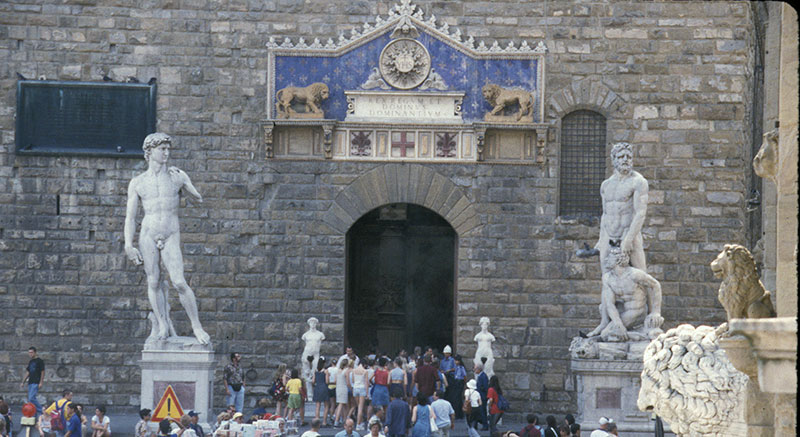
There are clusters of important statues in the Piazza della Signoria, but don’t be fooled by the big David, which is only a copy of Michelangelo’s original masterpiece that you must see tomorrow in the Accademia. Foremost in the square are Giambologna’s equestrian statue of Medici hero, Grand Duke Cosimo I, and Ammannati’s Neptune Fountain, but the best treasures are in the open arcade of the Loggia dei Lanzi. Cellini’s Perseus is probably the most outstanding of all the outdoor statues in Florence, cast in perfect bronze that a recent restoration has brought back to original luster. Unfortunately, the other statues are still being renovated, including Giambologna’s Rape of the Sabines, so this lovely arcade is somewhat marred -- but it still makes a good place to sit on the surrounding bench and rest your weary body.

While you are in the neighborhood, have a look inside Orsanmichele, a stunning small Gothic church with a dazzling Tabernacle holding a luminous portrait of the Virgin, recently restored to its original brilliance. However if this is the lunch hour, Orsanmichele will be closed, because, like most churches and many shops, things come to a screeching halt during mid-day siesta, which generally lasts from 12-3. The outdoor markets keep going all day, and you are right next to one of the best, so take some time to shop in the colorful Straw Market, also called the New Market, although it is 500 years old, just one block from Piazza della Signoria.
By now you should be tired and ready for lunch. For a splurge you could eat right here at Café Rivoire, at a table on their outdoor terrace with a fabulous view of the Piazza. Or cheaper yet in this same place, but without the view, you can always stand at their coffee counter and pay a much lower price, as in all Italian cafes. However, there are two casual restaurants a block away that offer some of the best food values in town.
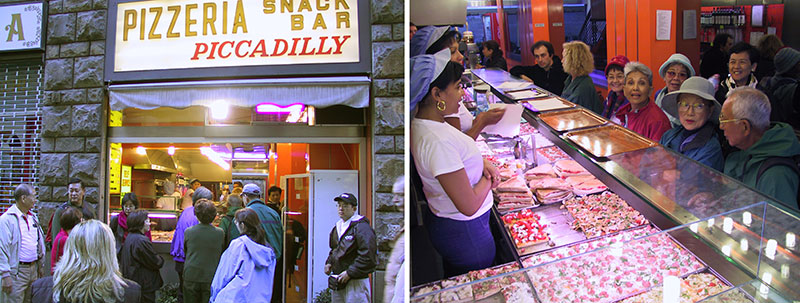
Piccadily Pizzaria, on Via Por S. Maria, the road leading to Ponte Vecchio, has great slices at low prices, with picnic tables in a garden setting out back. Better yet, the Hot Pot is my favorite cafeteria in town, around the corner on Via de Lamberti, across from Orsanmichele. There are half a dozen bargain cafeterias like this, where you can have a big meal for under ten dollars, especially during lunch hour when the food is very fresh.
After lunch and a little shopping, it’s time to visit the church of Santa Croce, where you will see very important early renaissance paintings by Giotto, Michelangelo’s tomb, and fine gothic architecture designed by Arnolfo de Cambio in the Middle Ages. Located just four blocks behind the Palazzo Vecchio, Santa Croce is an easy walk through a neighborhood filled with leather shops. There is also a nice Leather School in the back of the church with good values in locally made items.

Finally today, visit the Uffizi Gallery, which contains the finest collection of Italian Renaissance art, with masterpieces by Leonardo, Michelangelo, Botticelli, Bellini, Mantegna, Raphael, and many more geniuses, making this one of the top museums in the world. It’s a must for the art lover, and a major reason why people come to Florence, but it is small enough that you can easily walk through in 90 minutes. The problem lies in getting in, because this is the number one attraction in town and there is usually a long line, with a typical wait of 1-2 hours. Here are two ways to beat the line: call 011-39-055-294883 a few weeks ahead and make reservations, or time your visit for later in the afternoon, after 3:00 p.m. See our listings for the opening hours, but keep in mind this is Italy, so schedules may change.
Here are some tips for navigating in the Uffizi, and specific highlights to look for. When you enter, walk just beyond the killer staircase to the tiny elevators and ride up, saving yourself time and energy. Emerging at the top, notice the Medici busts, and try to identify Lorenzo, the magnificent patron of the Renaissance. First gallery on your left has two large paintings that look like typical inert Byzantine, but then notice they actually show signs of life, with some depth and perspective, because these are important works of Giotto and Cimabue that mark the very beginnings of the Renaissance. Moving along, you’ll run into Ucello and Pietro da Cortona, then in the next room, Filippo Lippi’s great “Virgin with Child and Angels.” Skip a room into the largest gallery with the main jackpot, Botticelli in all his glory, featuring “Birth of Venus” and “Primavera” along with another half dozen glorious paintings, including a spectacular Annunciation. In the next room, another Annunciation, but this time by Leonardo da Vinci, one of the few paintings he ever finished, and a piece he did with his mentor, Verrochio.
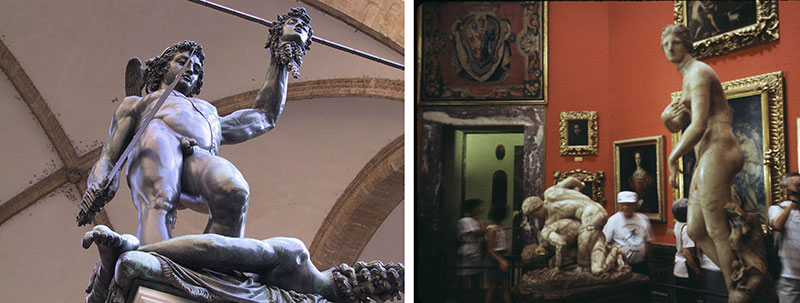
The next door along the main hallway leads to the Tribune, an octagonal red room with a pearl shell dome and classical statues in the middle. The paintings are rather dark and unimpressive, but the overall effect of this space is richly rewarding, so do wait on the little line to get in if necessary. You then follow the crowd into rooms with paintings by Durer, Cranach, Bellini, Giorgione and Mantegna, which you may breeze by or study as you like, heading to the South Corridor, which gives you a lovely view over the River Arno, especially nice in the direction of the Ponte Vecchio. Photography is no longer allowed in the museum, but it is OK to take a picture out the window of the classic view.
You are almost done, but there are two more rooms worth visiting, through the first door after you turn right into the West Corridor, where you will come face to face with a stunning Michelangelo masterpiece, the round “Tondo Doni” depicting the Holy Family. Did you realize that Michelangelo, the world’s greatest artist, made only three paintings on canvas? This is his best effort and worth contemplating. In the next room you can admire some brilliant works by Raphael, including portraits of himself and two important popes, Julius II and Leo X, a Medici who was the son of Lorenzo. Finally, make some direct eye contact with Titian’s grand life-sized nude, the “Venus of Urbino.”
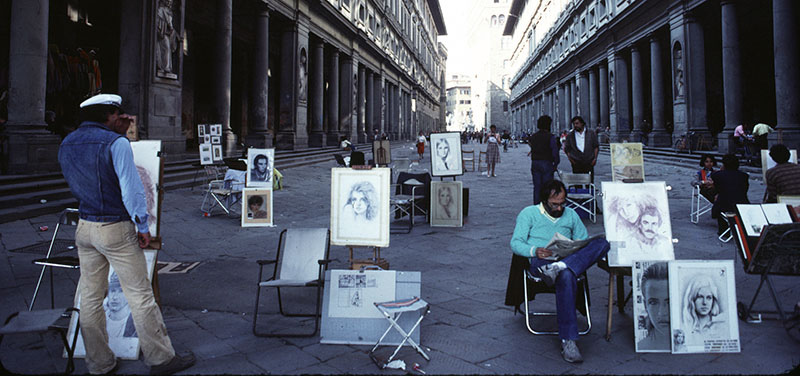
By this time most people’s feet and brains are giving up, so you can make a clean exit at the convenient staircase here, or…there are a few more rooms you could explore, especially if you want to see the Caravaggio “Bacchus” and the northern talents of Rembrandt, Rubens, Van Dyck and a few dozen more, in seven more galleries along the corridor. Good luck.
This was a huge day that covered nearly all the top attractions. By now you should be ready to return to your hotel and take a rest before dinner, but don’t make the mistake so many do at this point and fall into a deep sleep. You will wake up at midnight, all dressed up with nowhere to go and feeling mighty hungry. Instead, take a brief nap if needed, protected by your alarm and a wake-up call request for the front desk to blast you out of bed and into the night for a lovely dinner, because Florence is full of excellent restaurants that you don’t want to miss.
Piazzale Michelangelo, Pitti Palace, Oltrarno, Ponte Vecchio, shopping, Accademia.
Bus ride up to Piazzale Michelangelo.
A perfect way to begin this final day is enjoying the stunning view of the city from Piazzale Michelangelo on the other side of the Arno River. This is the one of the world’s great panoramas, so it is worth the effort to get here. It is too far and too steep to walk comfortably but you can easily find a taxi or better yet, catch the city bus in front of the train station for the quick, inexpensive ride across the river and up the hill. Then later you can easily walk back down to town. The vista takes in the full span of Florence, spreading below you in a sea of clay tile roofs, punctuated by many domes, towers, bridges and framed by hills in the background, with the commanding presence of the great Duomo rising above all. A full-size, bronze copy of Michelangelo’s David stands in the middle of the square, surrounded by a small army of vendors selling snacks, film, t-shirts and other souvenirs to the many visitors who will be sharing this popular view.
.jpg)
It only takes fifteen minutes to soak up the scene, but this brief expedition is most rewarding. When finished you could hail a taxi back into town, but there is a very pleasant walk downhill that leads to quiet lanes along the river, and then to the Ponte Vecchio, which you can reach in twenty minutes. To find this slightly hidden path, exit from the southwest corner of the square between the two snack bars where you will see a broad staircase descending the hill. This pedestrian lane, called Via Del S. Salvatore, continues through an impressive gate through a surviving segment of the ancient fortified wall, then joins up with Via di San Niccolo to lead you through a quiet, historic neighborhood of Renaissance palaces. In a few blocks you reach the Arno River and gain the best view of the most famous bridge in town, Ponte Vecchio, which is brightly lit by the morning sun and probably reflected in the shining mirror of calm water.
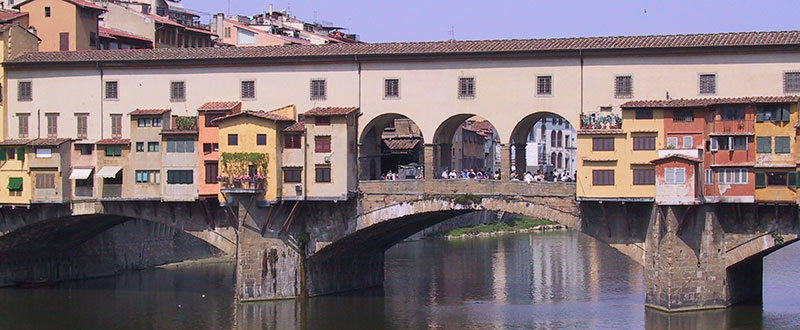
Ponte Vecchio is lined with high-quality, expensive gold shops that are completely free if you only browse, plus you get enjoy lovely views up and down the palace-lined river from the middle of the bridge. Notice the tiny second level where goldsmiths stooped to hammer, and above that, an enclosed corridor used by the Medici to get from palace to office, avoiding the conspirators below. Return to the Oltrano, as the neighborhood across the river from the main part of town is called, for some worthwhile explorations.
Pitti Palace, the former home of the Medici ruling dynasty, was the largest residence in Europe before Versailles was built, and was the royal home of the nation’s king, Vittorio Emanuele II, when Florence was capital of Italy, 1865-71. Now, it is one of the most important art museums in Italy.

The palace’s Palatine Gallery has a small but important collection gathered in six main rooms, that makes this an easy visit. Hint: start with the free, basement toilets, then take the elevator up to the galleries rather than climb that long, stone staircase.
The paintings are densely packed in, hung one above the other in the traditional way that reflects the original Medici system of showing their art treasures. These dazzling images, surrounded by lavish golden frames, hung on red velvet walls, provide almost too much stimulation, but the main attraction is waiting above you, in the ceiling murals by Pietro da Cortona, which are even more overwhelming than the paintings. The ceilings depict scenes from the life of a Medici, showing the education and maturity of the young prince, ending with his glorious apotheosis into heaven. On the walls you will enjoy masterpieces by Raphael, Rubens, Velasquez, Titian, Lippi, Perugino, Caravaggio, Van Dyke, Veronese and many more. Your visit includes ten worthwhile rooms of the royal palace, with many original furnishings. However, there are another dozen rooms of minor art along the courtyard that you can skip.
You have an option of visiting several more of the smaller galleries in this palace, each with its own separate admission, including the Silver Museum, with amazing trompe-l’oeil murals covering all the walls and ceilings in this 26-room collection of little sculptures.
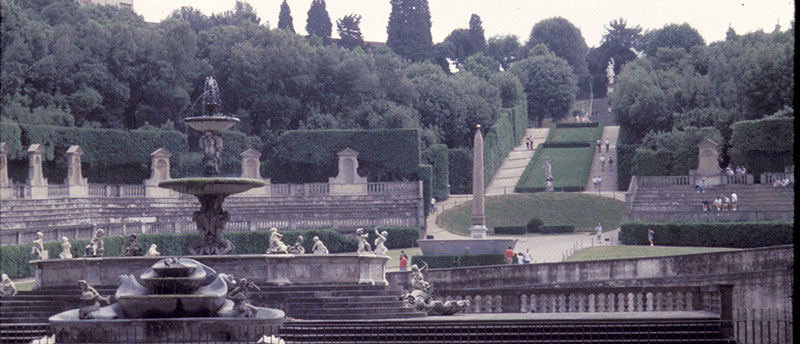
Afterwards, it would be most pleasant to have a stroll in the Boboli Gardens, a fine example of 16th and 17th century Italianate landscape architecture, with shaded paths leading up the rising hillside to a panoramic viewpoint. You could easily pass a pleasant hour in the gardens, finding the various fountains, and the cave-like Grotto just at the rear of the palace.
While you are on this side of the Arno, enjoy a stroll through past art galleries, antique shops, ateliers, little piazzas, and of course, more restaurants. Here you will find two important churches worth seeing.
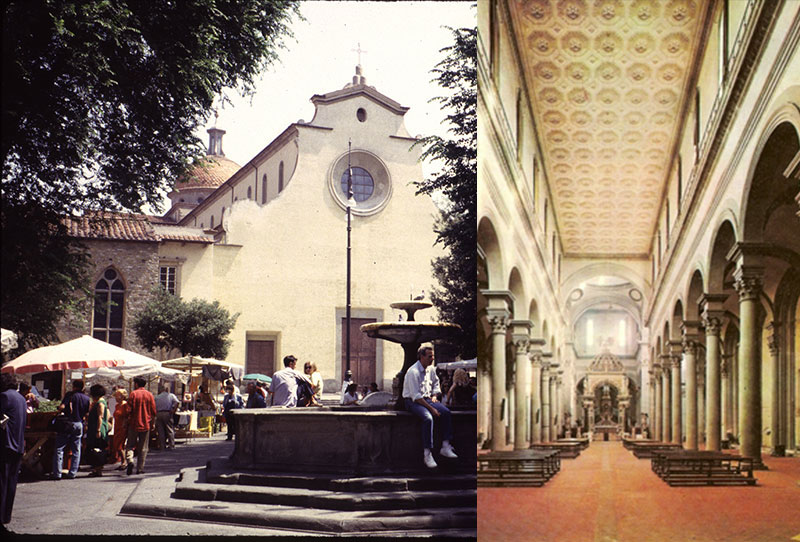
Santo Spirito, which sits on a picturesque, small piazza that often has an organic foods market, was serenely designed by Brunelleschi, Florence’s greatest architect, creator of the towering dome, who is also believed to have designed the original Pitti Palace. A small chapel on front-left side of Santo Spirito contains a wooden crucifix carved by Michelangelo, in payment to the friars who granted him special permission to dissect corpses for anatomical study. Keep walking several more blocks to the church of Santa Maria del Carmine, with the famous fresco cycle in the Brancacci Chapel by Masaccio, the painter who invented realistic perspective in the 1420s, bring art one giant step into the future.
CROSS THE ARNO:
Walk back across the Arno on the pretty Ponte Santa Trinita Bridge, which offers a fine view of Ponte Vecchio. You will emerge into a busy piazza with a tall column in the middle of the traffic intersection, and a restored palace on the right that is the world headquarters of Ferragamo, with an elegant shoe shop on the ground floor. The refined shopping street of Via de Tornabuoni leads from here into the center of town, but before heading in that direction, detour to the right, down narrow Borgo SS. Apostoli, that will lead you through a time tunnel, eight centuries back into the Middle Ages, with ancient palaces and tower houses lining both sides of this charming peaceful street. It only takes five minutes before you reach the busy Ponte Vecchio once again. Take two lefts and double back along Via delle Terme, another time tunnel with a similar archaic feeling, leading you back where you started at Piazza S. Trinita and the Ferragamo showroom.
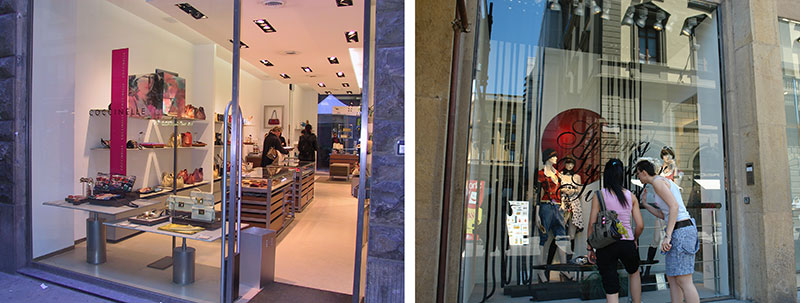
Now you are in position for a leisurely stroll along Via Tornabuoni, with its many fancy shops. For more glamorous boutiques, take a left in a few blocks, down one side of Via Della Vigna Nuova, and back up the other. You will find it is one of Europe’s great shopping streets, especially for the ladies interested in clothing, shoes, and accessories.
-08.jpg)
Nearby you will see the massive Strozzi Palace, which often has fascinating temporary exhibitions relating to the history of Florence, so peek into the impressive courtyard and see if the current show meets your interests. One block over is the Piazza della Republica, a big empty square that is not terribly interesting, but Gilli is a very pleasant café on the square that has a nice stand-up coffee bar, or tables outdoors, and convenient restrooms if you need them by now -- always a challenge. This area used to be a bustling center of town until it was all knocked down in a misguided 19th century urban renewal project.
By now it is probably deep into the lunch hour, and fortunately there are several outstanding restaurants nearby -- especially, Buca Lapi, in the basement of Palazzo Antinori on Via del Trebbio, or Buca Mario, on Piazza Ottaviani. You can always get by with a simple sandwich in any of the dozens of snack bars in town (remember, stand up to get cheaper prices), but if you only have a chance for a mere six meals in a city, you should have a few special lunches and some extraordinary dinners, especially when you’re in Italy! Live it up!
You are in striking distance of another fascinating church, Santa Maria Novella, located on the piazza of the same name. By now you might think this is some kind of religious pilgrimage, with several churches every day, but you have come to see art and the churches are where to find it. European artists in the old days spent most of their careers working for the church to create paintings, sculpture, and buildings for the glory of god -- so now we visit churches to see the results of this amazing work.
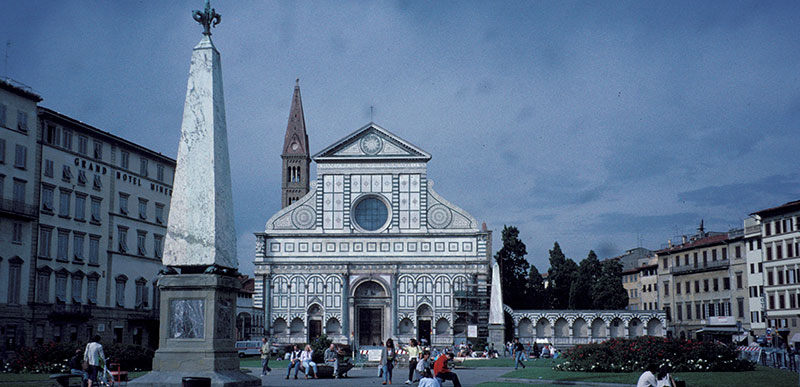
Santa Maria Novella is a good example, with the “Trinity” by Masaccio, considered the first painting to use perspective, showing true depth and proportions, along with glorious frescoes behind the altar by Ghirlandaio, an early teacher of the young Michelangelo. The church has many more art works, and is beautiful to see just for its harmonious Gothic architecture. Even if you don’t want to pay the 4 Euro to see another church, be sure to visit outside to admire the beautiful façade and the perfect piazza.
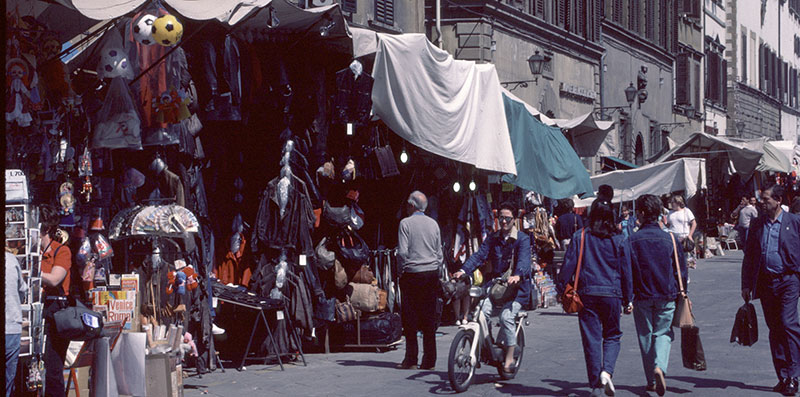
Another big church is coming up, but first you pass through the busiest outdoor market of town, alongside the church of San Lorenzo. This market is amazing! It is one of the largest in Europe, with about 150 different stalls, but of course most of the merchants offer the same things: belts, t-shirts, wallets, jackets, little statues, and souvenirs that say Florence. Don’t bother trying to bargain with these people -- they are not interested, unless you are buying a dozen items from the same person. The prices are pretty reasonable and the quality is ok, so this is a good place to spend, spend, spend. However, if you want top quality leather goods, stick to the real stores.
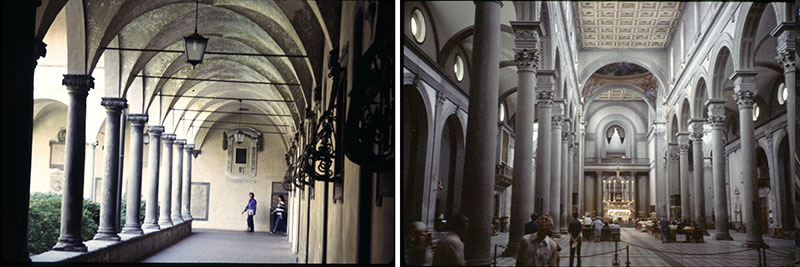
When you survive this gauntlet, you will emerge at the church of San Lorenzo, which charges admission. Anyway, once you get past the turnstiles, San Lorenzo is well worth it, because this is another architectural masterpiece by Brunelleschi. The church interior has a pleasant soft gray shading, with Tuscan columns and arches holding up the coffered ceiling, and many artworks, including two pulpits that were the final works of Donatelo. This was the family church of the Medici, who are buried here in Chapel, so you can be sure that extravagant resources went into this building, making it a delight to see. There is also one of the nicest cloisters in town, where you can sit and relax for a while to absorb the peaceful harmony of the garden square.
Now, continue on to the day’s next museum, primarily to see one statue -- Michelangelo’s David. Yes, this one piece is worth the three-block walk over to the Accademia Gallery. He stands 18 feet tall, a perfect marble figure ready to strike down the giant. Many feel this is the greatest statue ever created, and this reporter agrees, but words and pictures cannot do it justice, so you’ll just have to go and see for yourself. The problem is that everyone else in the world wants to visit David , so there are long lines outside the museum most of the time, which is pretty ridiculous when you consider these people are waiting up to three hours to see one statue. But we have a good system to beat the line: get there at the end of the day. The closing hours are a little tricky however, because like most museums, the ticket booth closes about 30 minutes before the museum closes, so don’t cut it too tight. If you arrive between 5:00 and 6:00 pm you should be fine, but the door closes at 6:20 pm. It is possible to make a reservation by calling 055-238-609, but that should not be necessary if you time it right.
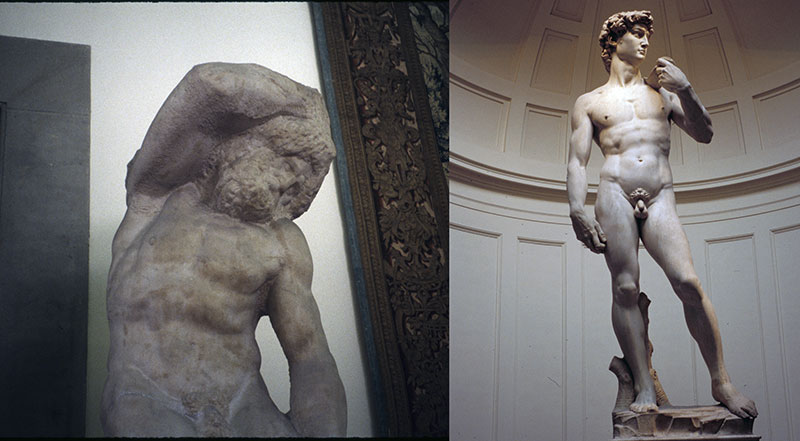
Once you are inside the Accademia, there are some other statues to enjoy along with the David -- in fact there is a whole room filled with Michelangelo’s work that most people blindly walk past in their obsession with David. Called the “Slaves” or the “Captives,” these unfinished statues were intended for the tomb of Pope Julius II, which never was built, even though Michelangelo worked off and on for half his career on this project. Because they are unfinished these pieces have an additional attraction, because they reveal the way in which the great artist cut stone, and vividly demonstrate his approach of liberating figures from the marble. Another room has a full-sized copy of Giambologna’s Sabines, and colorful paintings by Fra Bartolomea and Vivarini. Another long gallery has many plaster casts of famous statues that were used by the students when this was an art academy.
A few more museums, shopping, and a trip out of town.

Start with a visit to the Bargello, with the main collection of sculpture in Florence. Built in the Middle Ages, the Bargello has served many functions over the years, including Town Hall, courthouse, prison and museum. The original architecture is still intact, so the building itself is as interesting as its contents. It has an excellent selection of statues, including several by Michelangelo, and notable pieces by Giambologna, Donatello, Verrocchio, Brunelleschi and Ghiberti, important Renaissance sculptors.
A few blocks away is the towering presence of the Palazzo Vecchio, which you have seen from the outside several times already, but now you could take some time to enter the museum, which emphasizes domestic life of the noble ruling class of the city. This palace is one of the most important buildings in town, for the government has been meeting here for seven hundred years. It is the former residence and seat of power of the Medici who ruled Florence during the Renaissance. The museum visit will bring you through a few huge meeting halls as well as more intimate private rooms of the Medici, with many original furnishings, tapestries, paintings and sculpture.
Then you can catch up with sights you might have missed, or explore a few additional museums, or take a short trip out of town. For those wanting more history and culture, you could visit the Museo Archeologico Nazionale di Firenze, the largest archaeological museum in Italy north of Rome. Among other treasures it has four wonderful bronze statues dating back to Etruscan and Roman times, and an Egyptian collection. Your ticket to the Uffizi will get you in here for free. Opening hours are Monday, Tuesday, Wednesday, Saturday 8.30 am - 2.00 pm; Thursday and Friday 1.30pm - 7.00pm.
Nearby, you might visit the Convent of San Marco to see frescoes by Fra Angelico. Walking from one museum to the next, you will pass through Piazza dell a Santissima Annunziata, with a remarkable church filled with more artistic treasures, including the sculptured tomb of Giambologna and a huge ceiling mural. Notice the arcades along the side of the piazza, designed by Brunelleschi as part of another landmark building, the Hospital of the Innocents.
You have now seen nearly all of Florence, but here’s one more tip: If you are a big fan of Michelangelo, you might head over to Casa Buonarroti, his family’s house, two blocks north of Santa Croce on Via Ghibellina. While Michelangelo never lived there, he did pay for its construction to shelter his father and brothers. The museum has two of his original marbles, the Madonna of the Steps, and Battle of the Centaurs, along with some sketches, original household items, memorabilia and a nice gift shop.
EXCURSIONS:
An excellent alternative for his afternoon is to take a day-trip to Siena and Pisa, described elsewhere in this website, or Fiesole, on a hill overlooking Florence, just 5 miles away.
The trip to Fiesole is very easy and offers many rewards. Ride public bus 7 from the train station through the suburbs, passing numerous large well-kept villas and pleasant country scenery, arriving in Fiesole 20 minutes later. From the small town square you can easily walk to the principal sights, starting with the viewpoint next to Palazzo Vescovile, which offers a sweeping vista back across the hills to Florence, five miles away. There are signposts that will lead you through the Public Gardens and around to the real treasure of town, the Roman ruins with the spectacular amphitheater, and remains of a bathhouse, plus some earlier walls built by the Etruscans, who founded this town well before the Romans. There is also an excellent small museum in town with hundreds of artifacts recovered during excavations here. All these sights are open until 7:00pm daily.
Siena: A longer trip from Florence will take you one hour away to Siena, a classic, well-preserved example of a Tuscan Renaissance hill-town. You can get there on an organized tour, which is a little pricey, or go on your own by public bus, as we describe elsewhere.
The historic town of Siena is ideal for walking, so the main activity is to stroll through its narrow pedestrian lanes and find the main artistic and cultural highlights, including the cathedral, the main piazza, and several small museums. Most of the buildings here were constructed between 1200 and 1500, and really give you a feeling for life back in those days, especially since automobiles are excluded from the historic center.
Pisa: If you just must see the Leaning Tower of Pisa, you can easily get there in an hour from Florence, either on a guided bus tour or directly by train, as we describe elsewhere. This will eat up half your precious day, but for those itching to go it has its own rewards, especially now that the tower has been re-opened to visitors. If you want to climb it you shouldgo online and make reservation, as the daily number of entrances is strictly limited. Be sure to also visit the magnificent Romanesque cathedral and baptistery, which too many day-trippers overlook in their rush to see the tower and get back on the bus. Another advantage of going on your own by train is that you can take your time in this “Field of Miracles,” and then hop the city bus when you are ready to return to the train station for the hour ride back to Florence.
You can see there is so much to do in and around Florence that you could even stay more than three days if you want to do it all, but by all means, don’t attempt to cover this city in one day.
If you are looking for an excellent hotel to rest your head while touring this town, you can enjoy a relaxing stay at the Hotel Cerretani, a four-star property of MGallery Sofitel. This recently upgraded hotel is conveniently located in the pedestrian zone just 200 meters from the Duomo, and a short walk of 500 meters from the train station.
Touring the city, from the Hotel Cerretani, including Ponte Vecchio and Piazalle Michelangelo
Arrival, ride to Piazelle Michelangelo for the view, walk down, Piazza della Republica, Duomo
Walking tour with local guide and dinner at Porcospino
Walk with local guide Anne Barbetti to Baptistery and little lanes